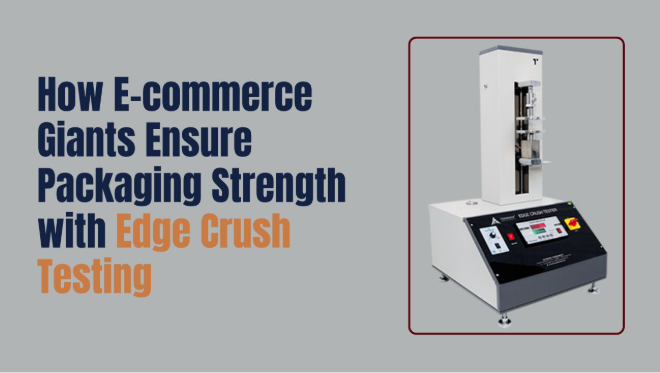In e-commerce, where hundreds of thousands of packages are being shipped every day across cities, countries, and continents, the strength of the package is an important determinant in delivering customer satisfaction. A bruised box can result in a returned order, a bad customer experience, and harm to a brand’s reputation. To prevent such incidents, e-commerce behemoths count on strict quality control procedures—one of the most important being the Edge Crush Test for corrugated boxes.
This blog delves into how industry leaders in e-commerce ensure the packaging materials live up to expectations, with attention to the essential role that the edge crush tester machine plays to ensure box stability during shipping and handling.
The Importance of Packaging Strength in E-commerce
With the exponential growth of internet-based shopping, corrugated boxes are the cornerstone of e-commerce supply chains. They are light, economical, and strengthened to withstand the rigors of shipment and handling.ส่งของไปจีน Their resistance to stacking, shipping forces, and abusive handling, however, relies significantly on their edge structural strength.
In a stacked truck or delivery warehouse, boxes are subjected to tremendous pressure from the top. If the edges of such boxes are not strong, the whole structure can collapse, leading to product damage. That’s why testing edge strength is not a choice—it’s a requirement.
What is the Edge Crush Test?
The Edge Crush Test (ECT) is a quantitative test used to determine the compressive strength of a corrugated board as pressure is put on its edge. It models the vertical pressure stacks that may be experienced by a box under actual logistics environments.
The test measures how much pressure the board can take before it breaks. This value, often given in kilonewtons per meter (kN/m) or pounds per inch (lb/in), enables packaging engineers to judge if a box can resist pressure or break early in transit.
Edge Crush Test for Corrugated Boxes: A Key Metric
For online businesses, the Edge Crush Test for cardboard boxes has also become a measure of quality. Rather than looking at the appearance or thickness of the material alone, this test gives numerical measures of how much weight the box can hold.
Boxes tend to be graded on their ECT rating, which can be a 32 ECT or 44 ECT. A 32 ECT box might withstand 32 pounds of pressure per inch on the edge. Based on the item being shipped and how much weight it is, various ECT values are selected to achieve the best cost without compromising safety.
The Role of Edge Crush Tester Machines
In order to perform this critical test, e-commerce logistics partners and manufacturers utilize specialized machines called edge crush tester machines. The machines apply compressive forces to a sample of the corrugated board until it breaks. The sample’s maximum capacity for force before it collapses is measured as the ECT value.
Up-to-date edge crush tester machines come with precision control, automatic logging of data, and a digital display to guarantee precision and reproducibility. Edge crush tester machines can also be set to undertake other compression tests, such as ring crush tests and flat crush tests, so that manufacturers gain a full perspective of board strength. Some advanced features of high-end edge crush tester machines are:
- Digital touch screen control
- High-resolution load cells
- Auto-stop functions on sample collapse
- Real-time graph plotting of force vs. time
- Multi-sample testing capabilities
How E-Commerce Giants Use Edge Crush Testing
E-commerce firms, particularly big players like Amazon, Flipkart, or Walmart, have high packaging standards. They maintain a close relationship with packaging suppliers and in-house testing laboratories and subject samples to periodic testing with edge crush tester machines. This is how the process usually goes down:
- Vendor Evaluation: The vendors must send samples of the packaging material, which then gets tested through certified labs via ECT.
- Box Design Optimization: Engineers can redesign boxes based on the ECT values for improved weight distribution and usage of materials.
- Quality Control in Warehousing: Periodic random samples of boxes are tested in fulfillment centers to verify continuous standards compliance.
- Damage Rate Reduction: Continuous testing eliminates packaging defects before they reach customers, lowering return rates and enhancing brand credibility.
Conclusion
To conduct precise and trustworthy edge crush tests, most packaging labs and companies rely on reliable equipment suppliers such as Testronix. Renowned for their state-of-the-art testing devices, Testronix provides quality edge crush tester machines based on international standards of testing. These machines are extensively utilized by the manufacturing of packaging companies, e-commerce logistics centers, and R&D centers to ensure each corrugated box that reaches the supply chain is fit for the next leg of its journey.
In a business where packaging is not simply a box—it’s the customer experience’s very first physical interaction—equipment like the edge crush tester is the unsung hero.

